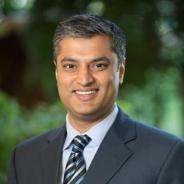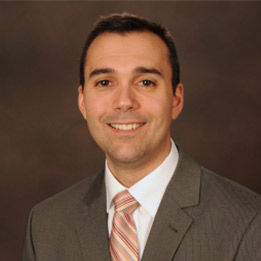Collaboration Stories
The purpose of this series is to tell the story of long-lasting, as well as emergent, stories of collaboration among clinicians and methodologists, content experts, and engineers, who have successfully worked on joint projects at the intersection of AI and health. Such collaborations are at the center of e-HAIL’s mission, and we offer these stories as a way of inspiring collaboration in other researchers.
“The Key to Our Success Has Been Finding Great Collaborators”

Brahmajee Nallamothu, M.D.
Stove Julius Research Professor of Cardiovascular Medicine
Professor of Internal Medicine – Cardiology
Michigan Medicine

Mike Dorsch, PharmD., M.S.
Associate Professor of Clinical Pharmacy
College of Pharmacy
Can you briefly describe the collaborative project(s) you have worked on? Are there any other key collaborators involved?
Mike: We have a number of joint projects, including the Wearables In Reducing risk and Enhancing Daily Life-style (WIRED-L) project, which is funded by the American Heart Association as part of its Strategically Focused Health Technologies & Innovation Research (SFHTIR) Network. This project is about improving diet, physical activity, and goal setting through the use of push notifications. Another collaborative project studies dietary interventions to reduce sodium intake with help of an app, and specifically focuses on how to improve patient engagement for longer-term use. And finally, together with the Centers in the SFHTIR Network, we’re doing a project on post-discharge heart failure intervention.
How did you get started on your first collaboration? How did you get to know each other, and how did you decide to collaborate?
Brahmajee: We have actually known each other for a long time on the clinical side, even if we are in very different medical specializations. In terms of my research, I come from a health services and outcomes research standpoint, where we’re trying to understand how technology can really change things at the bedside and at a population level. And through a mutual colleague I became aware that Mike had been doing some amazing, cutting-edge work on the areas of wearables and mobile technology, including very rigorous clinical trial development. So I reached out to Mike, because at that time in my career, I was thinking about similar ideas, and how to make such behavior modification interventions work in real life.
Mike: That’s good to hear, because I thought I pulled you in! I started at U-M as a clinician, and was always aware of the great research going on around me, including that of Brahmajee. I eventually moved over to the tenure track, and our collaboration really started when Brahmajee stepped by to talk about my poster at the annual conference of the American Heart Association.
Brahmajee: It’s funny how you sometimes have deeper conversations outside Ann Arbor, even if you’re at the same institution. What also helped: we had a deadline, which gave us a focus and a reason to go explore more deeply how we could work together on this application for the SFHTIR network funding.
You are both in the medical field. How do you involve engineers, computer scientists in your collaboration?
Mike: We couldn’t do any of this without our colleagues Walter Dempsey in Biostatistics (SPH), who has great expertise in micro-randomized trials and adaptive modification, and Mark Newman from the School of Information, who is crucial from a technical and behavioral intervention standpoint. I also work very intensively with the two programmers who do much of the technical work.
Brahmajee: The key to our success, with us coming from the clinical side, has definitely been finding great collaborators, to whom I’d just add Pedja Klasnja as well.
How do you make sure that all collaborators get something out of the project that makes it intellectually stimulating to them, exciting from their perspective and scientific background? Has this happened organically or do you put specific measures in place to accomplish this?
Brahmajee: Some of the things I have learned, especially when it comes to larger projects, is that it is really important to be very thoughtful about how to put all the pieces together, and to select the right partners who are well aligned in terms of research interests. It’s not viable in the long term if the project doesn’t fit someone’s interest. Of course, many of us are in an academic environment, because we enjoy thinking about things outside of our own space. So, if you can work on the edges, that seems to be a powerful way of moving things forward.
Second, you want to work with people who have an open attitude towards your not knowing certain things and being outside of your scientific comfort zone. It’s tough to collaborate because you make yourself vulnerable and are sometimes asking really basic questions. And third, it’s also helpful to have explicit conversations around roles, expectations, and how to make sure everyone gets to share in the credit accruing to the work. When there’s perceived scarcity, it can make things uncomfortable, but there’s enough credit to go around and different collaborators can publish in discipline-specific top journals.
Mike: Absolutely. Explicit communication about who is going to do what is crucial, as is understanding the different reward structures in different disciplines, including different goals for getting tenure and promotion.
What is the most surprising thing you have learned from collaborating with each other?
Mike: Maybe this shouldn’t be surprising, but it has been a nice surprise to forge connections outside of the work: these are really important, and I’ve been surprised by how down to earth my collaborators are.
Brahmajee: Yes, these collaborations have really been a ton of fun. I’ve also learned a lot, and explored ideas and approaches in much more depth than I’d otherwise would, just because collaborators send you articles in journals you wouldn’t seek out on your own. For example, the community-based and health equity-based research that our collaborator Lesli Skolarus does is something I only had a superficial understanding about five years ago. So it’s been great to learn about health equity research through her, and even to be able to work on a project that is trying to move the needle in that space, even in the smallest of ways.
Why do you think collaborative and interdisciplinary research is important? Is this particularly the case for research at the intersection of AI and health? If so, why?
Brahmajee: Collaborative research is fundamentally focused on the intersection of divergent areas and the greatest creativity is when people work in that space and can see applications that move from one field to another. That’s particularly important for AI and healthcare, because on the one hand we have clinicians who see challenges in their daily work, but have little idea of the tools that may be available for solving problems. And on the flip side, the methodologists who have an idea of what’s possible may have trouble knowing what is important, especially in something as complex and nuanced as healthcare.
Mike: I think it’s extremely important to have collaboration in the AI and health space. I see us as a Venn diagram, where all of us have some overlap in terms of expertise; when we get together, the middle of the Venn diagram is where the sparks are, where the new things happen. You need to speak a little bit of each other’s language to make that possible.

 MENU
MENU 
